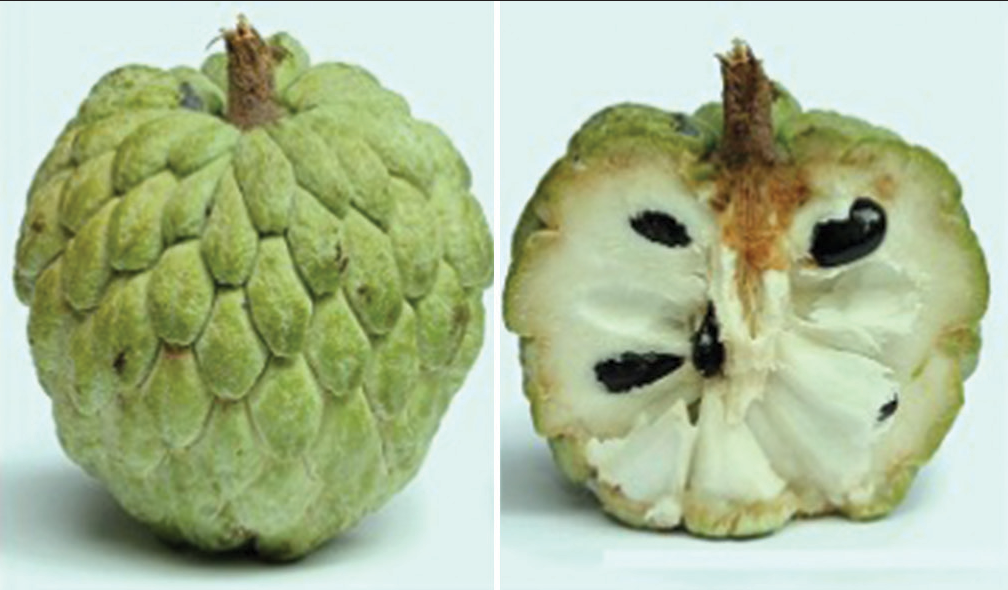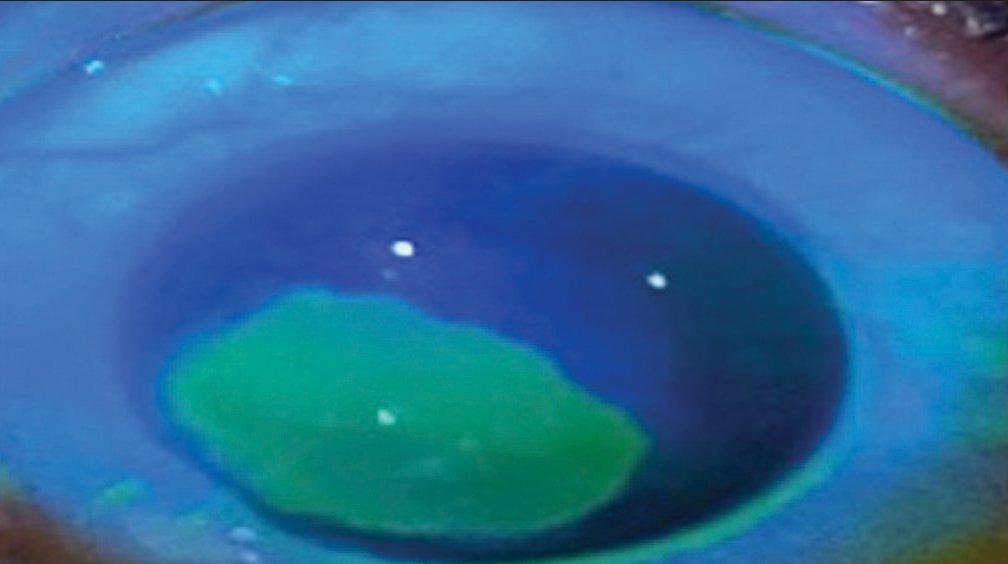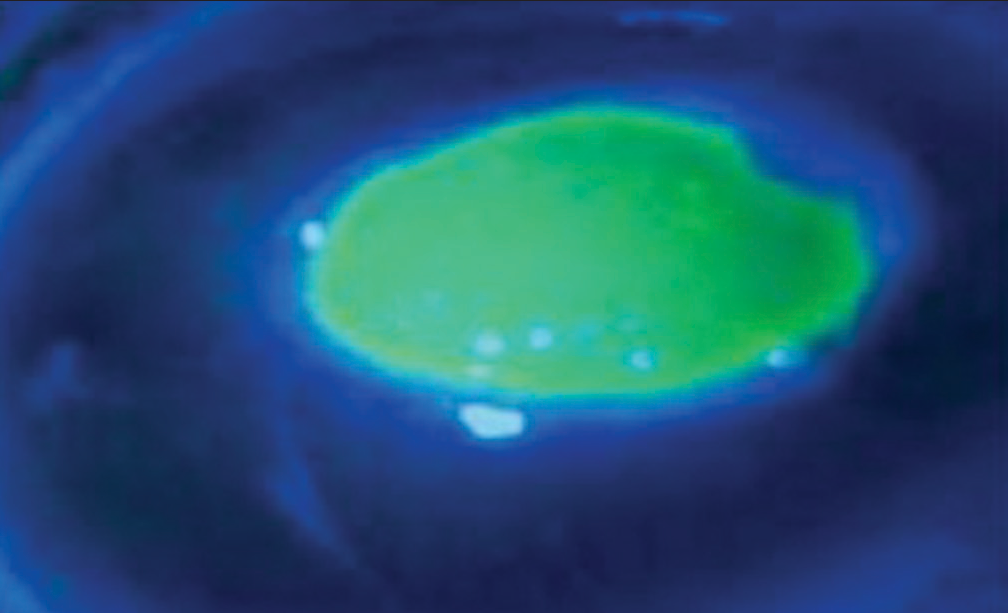Translate this page into:
Custard apple seeds induced toxic keratoconjunctivitis
*Corresponding author: Payal Gonde (Ballamwar), Department of Ophthalmology, Vasan Eye Care, Secunderabad, Telangana, India. payalgonde@gmail.com
-
Received: ,
Accepted: ,
How to cite this article: Gonde (Ballamwar) P. Custard apple seeds induced toxic keratoconjunctivitis. Glob J Cataract Surg Res Ophthalmol, doi: 10.25259/GJCSRO_14_2023
Abstract
The patient developed severe symptoms of toxic keratoconjunctivitis within 6-12 h following accidental ocular exposure to custard apple seeds (Annona squamosa) which are used as a remedy for lice/dandruff in some parts of India. A 12 year-old female child was diagnosed with custard apple seed-induced toxic keratoconjunctivitis. A patient with informed consent was enrolled. She was advised to use topical antibiotics, lubricating agents and cycloplegic eyedrops. She responded well to treatment and keratoconjunctivitis resolved in 3 weeks with complete restoration of vision in both eyes. This case highlights the importance of prevailing traditional practices. Simple health education and more public awareness of harmful effects of custard apple seeds should be created to prevent such chemical injury.
Keywords
Custard apple seeds
Annona squamosa
Keratitis
Harmful traditional practice
Keratoconjunctivitis
INTRODUCTION
Due to its sweet taste, the edible tropical fruit known as the custard apple (Annona squamosa L.) is additionally known as the sugar apple. The custard apple is a fruit of the A. squamosa or Annona asiatica plant, which is a member of the Annona genus and Annonaceae family[1] [Figure 1]. It contains active compounds such as alkaloids-cyclohexapeptides and acetogenins (ACGs).[2] It is produced throughout India. Injurious traditional folk medicine uses various components of this plant to cure a variety of ailments, including boils, ulcers, maggot-infested wounds, head lice and skin exfoliation.[3] In some regions of South India, it is common for them to come into contact with the eyes accidentally, particularly when they are used as a traditional treatment for dandruff and lice infestations of the scalp or as a skin exfoliator for the face. Studies on the A. squamosa seed’s phytochemistry and pharmacology have revealed that the main bioactive substances are ACGs.[2] Here is a case report wherein the patient developed custard apple seed-induced keratoconjunctivitis following accidental ocular exposure to it.

- Custard apple.
Mechanism of action
Annosquacins A to D (1–4), annosquatin A (5) and annosquatin B (6) were discovered through phytochemical analysis of the ethanol fraction of custard apple seeds. ACGs have a wide range of biological characteristics, including anti-inflammatory, cytotoxic, immunosuppressive, pesticidal, antiparasitic and antibacterial effects.[4] The isolation of eight cytotoxic acetogenins from the seeds of A. squamosa.[5] It has a wide range of nutritional benefits and numerous health advantages for individuals.[6] Research studies on the mechanisms of action revealed that the mitochondrial respiratory chain complex I (Nicotinamide adenine dinucleotide: Ubiquinone oxidoreductase), one of the respiratory complexes that produce the proton-motive force needed for the production of Adenosine triphosphate (ATP) in mitochondria, is the most effectively inhibited by ACGs.[7]
CASE REPORT
A 12-year-old female child reported to the Department of Ophthalmology in a Tertiary Eye Care Hospital with the chief complaints of inability to open both eyes, which were associated with lid swelling, defective vision, redness, watering and ocular pain for 1 day. Her mother gave a history of having applied custard apple seeds ground to paste to the child’s hair as a remedy for dandruff. On examination, her eyes were opened with difficulty, and her visual acuity was 20/80 in the right eye and 20/120 in the left eye. Slit-lamp examination of the right eye after applying topical anaesthetic eye drops revealed conjunctival congestion and a stain-positive large corneal epithelial defect with punctate epithelial erosions [Figure 2]. The left eye revealed conjunctival congestion and a stain-positive large corneal epithelial defect with surrounding punctate epithelial erosion and loose epithelium [Figure 3]. No anterior chamber reaction was noticed in both eyes. Intraocular pressure was 11 mmHg and 12 mmHg in the right and left eyes, respectively measured by hand-held Tonopen. She was diagnosed with toxic keratoconjunctivitis in both eyes (within 6–12 h following accidental ocular exposure to the custard apple seeds). According to Dua’s classification of chemical injury grading, the patient was included in Grade 1 ocular chemical injury.[8]

- Slit-lamp photo of the right eye showing large epithelial defect with surrounding punctate epithelium erosions.

- Slit-lamp photo of left eye showing large epithelial defect with surrounding punctate epithelium erosion and loose epithelium.
She was advised to use preservative-free moxifloxacin hydrochloride 0.5% eye drops 4 times/day, topical lubricating eye drop 8 times/day and homatropine 2% eye drops 3 times/day. She responded well to treatment, and toxic keratoconjunctivitis resolved in 3 weeks with complete restoration of vision (20/20) in both eyes [Figures 4 and 5]. She was advised to continue lubricants for a week and asked for a follow-up after 6 months.

- Right eye after treatment.

- Left eye after treatment.
DISCUSSION
When in contact with the eyes, the liquid of the crushed custard apple seeds, which includes active chemicals, can lead to abnormalities in epithelial integrity. A. squamosa seed extract causes permanent unilateral or bilateral visual impairment by being toxic to ocular structures, particularly the corneal epithelium. Poor adherence of the corneal epithelium to the underlying stroma is the pathogenic mechanism.[9,10]
A case series of six patients with custard apple-induced keratopathy was reported by Nagaraja et al. in 2016.[11] They recommended avoiding topical steroid therapy in these patients during the acute phase before epithelial healing due to the high occurrence of secondary infections with bacteria that may harm vision. However, the rate of re-epithelialisation was not affected by topical steroids administered starting on the 3rd day following de-epithelialisation. However, if the injury is older, steroids may be given without worrying about wound healing.[12]
Two cases of custard apple-induced keratopathy have been managed with epithelium debridement, topical antibiotics and patching, according to a 2017 study by Devi Nivean et al.[13] Gandhi et al. published the largest series, in which they reported 19 similar cases.[14] According to Dutta et al., routine eye patching is ineffective in the healing of mild corneal abrasions.[15] Corneal abrasions and erosions may arise from chemical exposure caused by the toxin.[9] Matrix metalloproteinase activity that is excessive can lead to the pathophysiology.[11] The abrasions get worse when the lids are constantly moving.
In this case, the patient improved significantly more quickly and experienced symptomatic relief without the need for a patch. No need for topical steroids is required. The patient did not worsen or develop any complications thereafter. Although there was no evidence to suggest an infectious aetiology, topical antibiotics were administered to stop any secondary infection that may occur. Lubricants contributed to the faster and more effective healing of the cornea. Steroids should be avoided in such cases during the acute phase before epithelial healing, as previously described by Nagaraja et al.[11]
CONCLUSION
This case report highlights the importance of prevailing traditional practices. Simple health education and more public awareness of the harmful effects of custard apple seeds should be created to prevent this kind of chemical injury by focusing on the preventive aspect rather than the curative.
‘The key to avoiding chemical injuries is prevention, and our greatest weapon is health education and awareness. Traditional practices change as an outcome of increased public awareness, making safety and life protection the standard.’
Declaration of patient consent
The authors certify that they have obtained all appropriate patient consent.
Conflicts of interest
There are no conflicts of interest.
Financial support and sponsorship
Nil.
References
- Six cytotoxic annonaceous acetogenins from Annona squamosa seeds. Food Chem. 2012;135:960-6.
- [CrossRef] [PubMed] [Google Scholar]
- Insecticides from Plants Insects: The Year Book of Agriculture United States: USDA; 1952.
- [Google Scholar]
- Acetogenins from Annona cornifolia and their antioxidant capacity. Food Chem. 2010;122:1129-38.
- [CrossRef] [Google Scholar]
- Monotetrahydrofuran annonaceous acetogenins from the seeds of Annona squamosa. Phytochem Lett. 2012;5:33-6.
- [CrossRef] [Google Scholar]
- Beneficial aspects of custard apple (Annona squamosa): A perspective review. Int J Res Appl Sci Eng Technol. 2022;10:1108-15.
- [CrossRef] [Google Scholar]
- Essential structural factors of annonaceous acetogenins as potent inhibitors of mitochondrial complex I. Biochim Biophys Acta. 1998;1365:443-52.
- [CrossRef] [PubMed] [Google Scholar]
- A new classification of ocular surface burns. Br J Ophthalmol. 2001;85:1379-83.
- [CrossRef] [PubMed] [Google Scholar]
- Pathogenesis, clinical features and management of recurrent corneal erosions. Eye (Lond). 2006;20:635-44.
- [CrossRef] [PubMed] [Google Scholar]
- Chemical injuries of the eye: Current concepts in pathophysiology and therapy. Surv Ophthalmol. 1997;41:275-313.
- [CrossRef] [PubMed] [Google Scholar]
- Ocular toxicity by seeds of Annona squamosa (custard apple) Indian J Ophthalmol. 2016;64:611-3.
- [CrossRef] [PubMed] [Google Scholar]
- Corneal reepithelialization and anti-inflammatory agents. Trans Am Ophthalmol Soc. 1982;80:758-822.
- [Google Scholar]
- Custard apple seed induced keratitis: A harmful traditional practice in South India. GMS Ophthalmol Cases. 2017;7:Doc23.
- [Google Scholar]
- Toxic keratitis after application of custard apple seed for head lice infestation. Cornea. 2019;38:948-50.
- [CrossRef] [PubMed] [Google Scholar]
- Effectiveness of patching and non-patching in treatment of corneal abrasion: A comparative study. Indian J Clin Exp Ophthalmol. 2020;6:616-21.
- [CrossRef] [Google Scholar]







